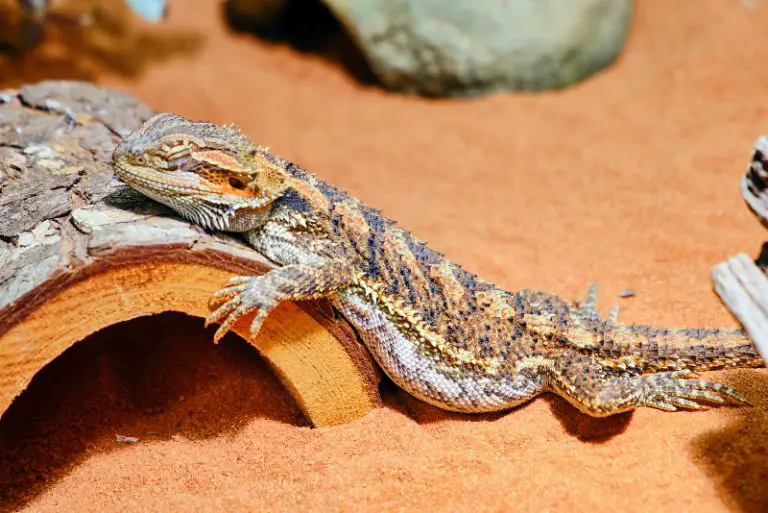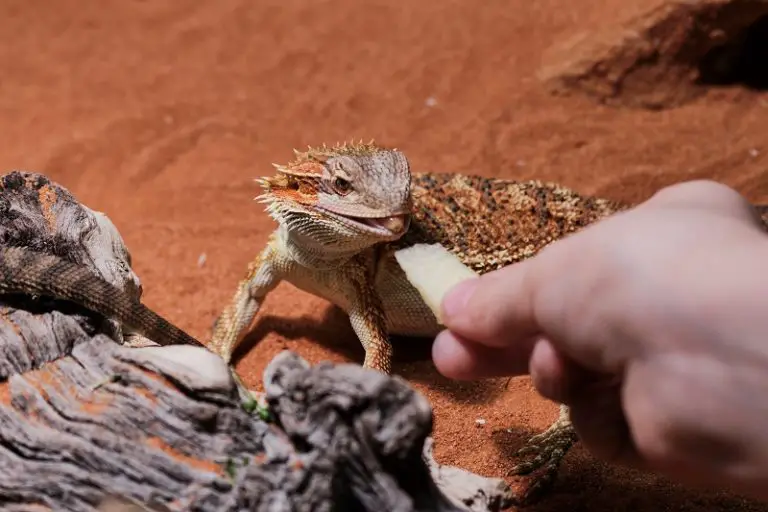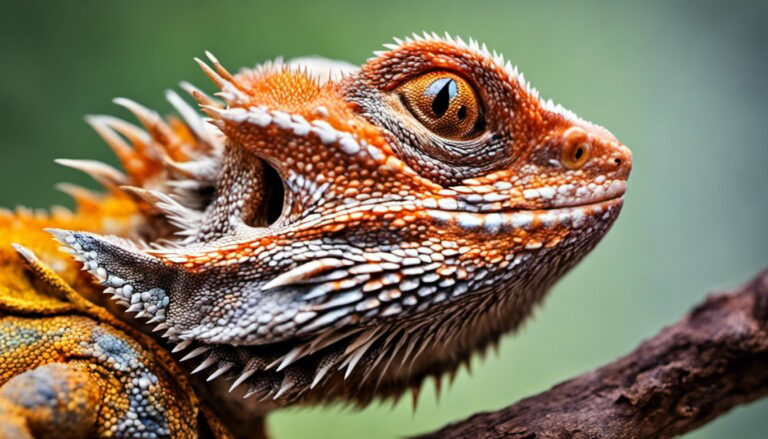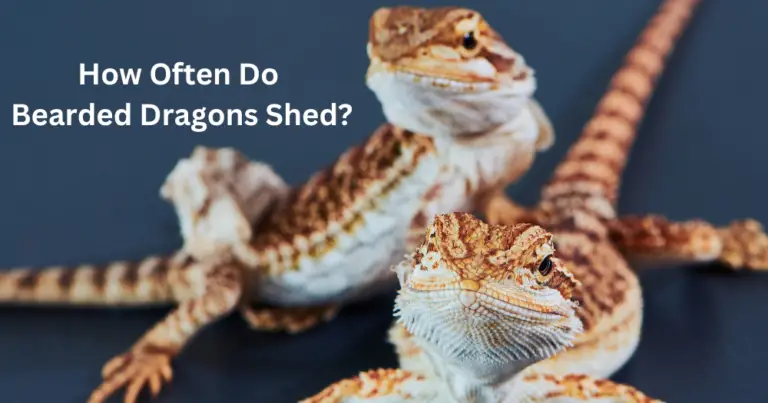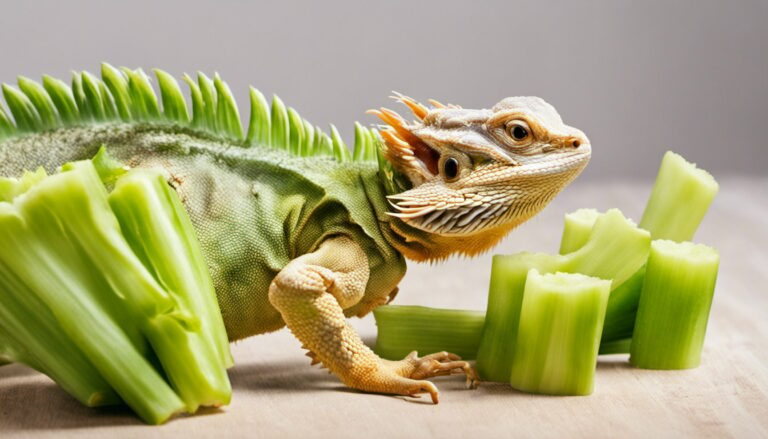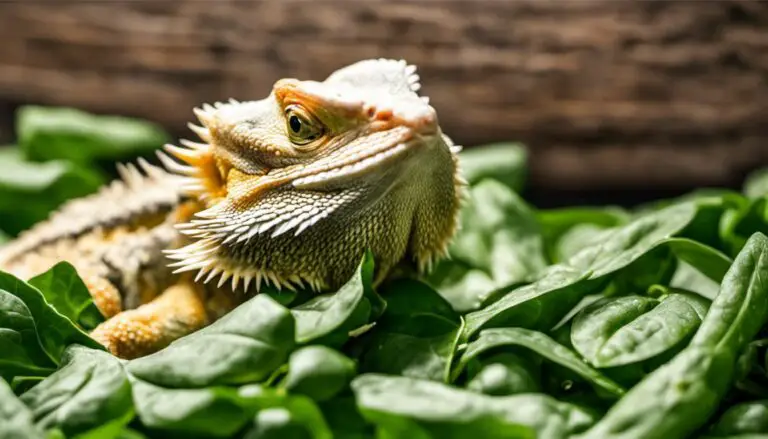How Do Bearded Dragons Mate? Pregnancy, Eggs & More
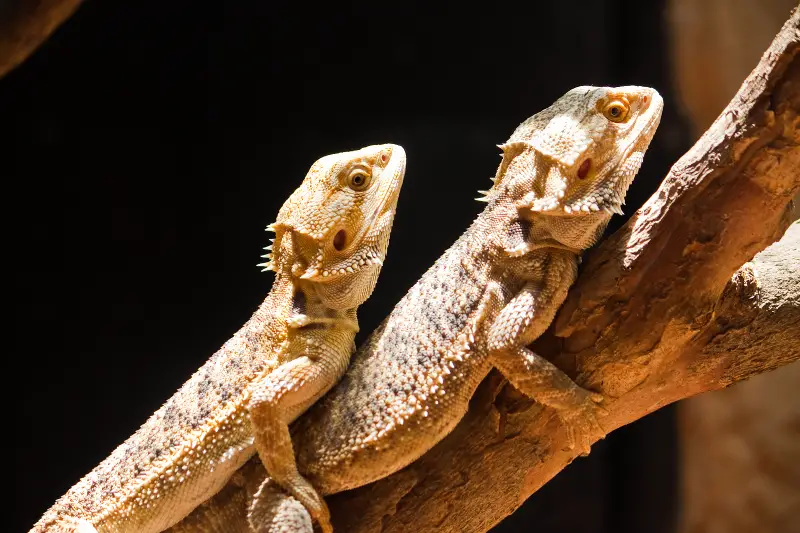
Bearded Dragons make a fantastic pet for anyone and for many reasons. However, even though they’re a delight to have at home, you may be tempted to get more than one. Maybe you’ll even be tempted to breed your Beardies.

Unfortunately, Bearded Dragons prefer the company of their humans rather than other Beardies. And yet, it’s extremely easy to breed them. But is it the best option for them?
In this article, we’ll give a brief overview of the Bearded Dragon. Then, we’ll share everything from knowing the signs of a male and female ready to mate and how to prepare them for mating. Then, we’ll go through the steps of how to breed Bearded Dragons, pregnancy, helping your female lay her eggs, hatching those eggs, and then caring for the hatchlings.
Contents
Table of Contents
What Is A Bearded Dragon?
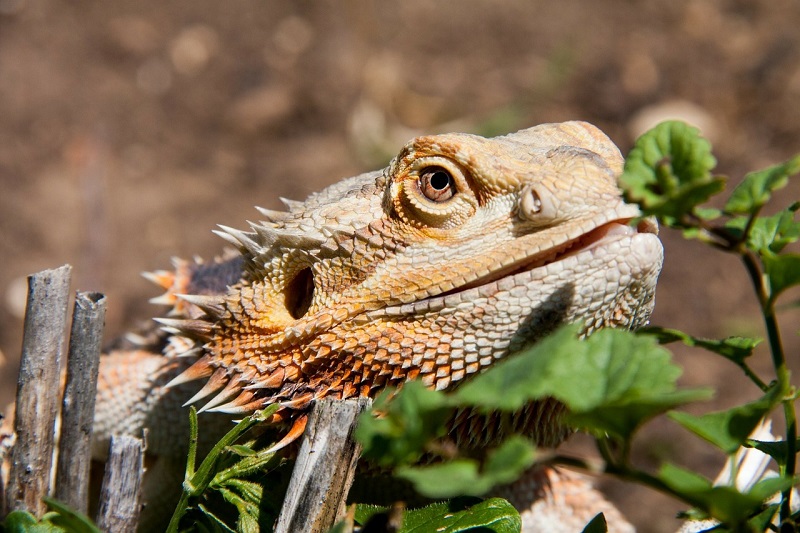
Bearded Dragons are a type of reptile that can come in eight different species. If you decide to get this lizard, then you might even find them in a few different colors, such as red or yellow.
Also known as Beardies, this reptile comes from Australia. They’re used to warm, dry temperatures so you’ll need to mimic this as best as possible in their terrarium.
For instance, they need a UVB light and a basking lamp. The basking spot should be 95 to 100 degrees F during the day and off at night.
The rest of the tank should be 75 to 85 degrees F during the day. At night, it should be between 65 and 74 degrees F.
With proper care through nutrition and exercise, you can count on your Beardie growing to be between 16 and 24 inches long. Also, they have an average lifespan of up to ten years. However, some Bearded Dragons in captivity have been known to live for up to 15 years.
Overall, Bearded Dragons make wonderful pets. They’re friendly, social, and are more active during the day. For instance, they’ll love to hang out with you and play.
How To Tell A Male From A Female Bearded Dragon
There are a couple of different answers to how to tell male from female Bearded Dragon.
First, you can lay your Beardie on a flat surface and lift up their tail at a 90-degree angle. Both genders will have a hemipenal bulge at the base of their tail.
For example, a male will have two on either side of the tail’s base. On the other hand, a female will have one hemipenal bulge in the center of her tail’s base.
If it’s dark and you have a hard time seeing the bulge, then you use easily use a flashlight to see it.
You can tell the sex of your Bearded Dragon male or female early on but it might be best to wait until they are at least eight to 12 weeks old. When they’re young, they’ll move around a lot so it’ll be difficult to look.
By the time your Beardie is three months old, you’ll have a better chance of them being still for you tell their sex.
Can Males And Females Live Together?
Males and females should not live together. There are a few reasons for this. First, Beardies enjoy being alone. They don’t necessarily care for other Bearded Dragons and would much rather hang around their owners. Also, males and females together would surely mean you’ll end up having baby Bearded Dragons. Of course, if you’re thinking of breeding Beardies together, then this is totally fine as long as you know how to care for your Beardies through the process.
In addition, the male can become aggressive with the female when he wants to mate, thus stressing the female out and possibly causing her harm. So, be sure to do research and understand how to support both your male and female Beardie during this time.
Should You Breed Bearded Dragons?
You should not breed your Bearded Dragon together unless you’re a professional breeder. It’s a lot of work and happens quickly. For instance, if you put a male and female together, you might have babies sooner than you think. The only reason you would breed Beardies together is to make a profit from the babies, which is not a good reason to breed Bearded Dragons together.
How To Prepare To Breed Bearded Dragons
As mentioned earlier, Bearded Dragons do not like to be housed together. So, you’ll want to set up a separate tank specifically for breeding.
In that tank, you can move your male and female in there together. The male will most likely want to mate. The female, on the other hand, may or may not want to mate.
Keep a close eye on them. If the female wants to mate, great. Let them do their thing with supervision (just in case it gets too aggressive).
However, if you notice the female not responding to the male and chasing her down, it could become too stressful for the female. Also, the male might hurt her. So, you’ll want to take them out and put them back into their enclosures.
If they end up mating, you can put them back into their terrariums. Then, the male can go about his day as normal, but you’ll want to keep a close eye on the female.
For example, make sure she’s basking, eating well, is getting extra calcium and vitamin D.
Before Mating
However, before you try putting the two of them together, you’ll want to bring them both to the vet. Talk to the vet about your breeding plans and let them help you. Learn all you can about Bearded Dragons, mating, and caring for hatchlings.
So when do Bearded Dragons mate? Since they’re in captivity, you can breed them whenever you want. In the wild, though, it’s natural for them to go through brumation and then mate when they wake up.
So, you can allow them to go through the brumation process in the cold months. Then, when they wake up in the spring, you can begin the mating process.
After Mating
Your female will only be pregnant for a couple of weeks, so you have a short time to prepare.
Get a separate tank or a container that’s big enough for your female to walk into and turn around in. Fill it a few inches deep with dirt substrate that’s safe for Bearded Dragons.
When you notice your female digging a lot or trying to escape her enclosure, you can move her to lay spot in the container.
There, she’ll dig a hole and begin laying her eggs in the dirt.
Also, before, during, or after she lays her eggs, you’ll want to set up an incubator space. This is where the eggs will safely hatch after a couple of months.
When your female is done laying her eggs, you can put her back into her enclosure. She’ll be weak, so continue to give her extra calcium and TLC.
Exactly How Do Bearded Dragons Mate?
So, how do Bearded Dragons reproduce? They lay eggs after mating. Here are some signs they’re ready to mate.
Signs Of Bearded Dragon Wanting To Mate
When a male and female Bearded Dragon are ready to mate, they’ll both act differently. For instance, a male will be ready to mate before a female is ready.
Signs A Male Bearded Dragon Is Ready To Mate
Males will do the following:
- Turn their beard black
- Bob their head a lot
- Stomp their feet in the presence of a female
In addition, males are aggressive when they’re ready to mate. They’ll chase the female around and even bite her neck to keep her still so that he can mount her.
Signs A Female Bearded Dragon Is Ready To Mate
Females are more subtle about wanting to mate. They won’t necessarily initiate the act of mating.
However, they will wave to the male Beardie in response to their head bobbing to show they’re ready to mate.
How Often Do Bearded Dragons Breed?
Bearded Dragons will breed about once a year in the wild. Of course, a male can breed with multiple females at once. Females, on the other hand, should only breed about once a year for their health.
However, pregnancy is short in Bearded Dragons, so in captivity, they could be bred twice a year. However, it’s never a good idea to do that. You want to keep both your male and female strong and healthy.
Bearded Dragon Breeding Season
Yes, Bearded Dragons do have a breeding season when they’re in the wild.
In Australia, their native habitat, Bearded Dragons will brumate in the colder months. When they wake up in the spring, they’ll be ready to mate.
Read more about Bearded Dragons and brumation here.
However, in captivity, Bearded Dragons can mate at any time of the year. They don’t need to brumate because they’re in an enclosure.
Some breeders prefer to allow their Bearded Dragons to brumate in captivity and then mate afterward in the spring to keep the process as natural as possible for the reptile.
How Old Do Bearded Dragons Have To Be To Breed?
The breeding Bearded Dragons age should be at least 18 months old when they’re ready to mate. Beardies aren’t considered to be adults until they are 18 months old.
However, if you’re going to breed your Beardies together, it’s best to wait until they’re at least 24 months old or two years.
You want to be sure that they’re healthy, strong, happy, and mature enough to start breeding a Bearded Dragon.
Bearded Dragons And Pregnancy
So, how long are Bearded Dragons pregnant for? Here’s all the information you need about female Beardies being pregnant.
How To Tell If Bearded Dragon Is Pregnant
There are a few ways to tell if your Bearded Dragon is pregnant or gravid. She’ll begin to show the following signs:
- Restlessness
- Digging more often
- Increased appetite and then decreased appetite
If she’s showing these signs, then she is most likely pregnant. In addition, her belly may look bloated, which means she’s carrying eggs.
How Long Is A Bearded Dragon Pregnant For?
Bearded Dragons are pregnant for about four to six weeks. So, once you know that your Bearded Dragon is pregnant, you’ll have a small window to prepare for the babies.
About a week or two before she lays her eggs, your female Beardie will begin to dig a lot. You can use this as a cue to get everything set up for the arrival of the eggs.
How To Care For A Pregnant Bearded Dragon?
When your female Bearded Dragon is pregnant, you’ll want to give her plenty of extra TLC. She’ll also need more nutrients than normal.
For example, she’ll need more calcium than normal. So, giving her calcium supplements is a good idea.
Calcium is not only needed to keep the mother healthy and growing strong but it’s needed to develop the eggs and babies healthily.
In addition, you want to make sure that the heating and lighting in her tank are at the correct temperatures and that she’s getting plenty of heat and light during the day.
Proper heat and lighting are also essential to help develop the eggs and babies.
Finally, you want to make sure she’s getting plenty of vitamin D3 from the natural sunlight. You can give her vitamin D supplements, but getting it from the natural sun will be better.
This is another reason why it’s best to breed your Bearded Dragons in the spring or summer. Then, you can bring your female outside and allow her to relax in the sun for a bit each day.
Finally, you want to set up a laying area. An incubator will be an excellent purchase, so it’ll help the eggs grow before being hatched. Also, your Beardie will dig a lot, so you’ll need to set up this area for her.
Caring For Bearded Dragon Eggs
Caring for Bearded Dragon eggs and the hatchlings takes a lot of work, so here’s what you need to know.
How Many Eggs Do Bearded Dragons Lay?
How many babies do Bearded Dragons have? Bearded Dragons lay eggs in clutches. Each clutch has about 20 eggs at a time. However, some have been known to have up to 30 eggs.
During one pregnancy, a female Beardie can lay anywhere between one to four clutches. This means they lay anywhere between 20 and 80 eggs at one time.
Of course, if they lay up to 30 eggs in one clutch, you could end up with 120 eggs!
How Do Bearded Dragons Lay Eggs
You’ll be able to tell that your Bearded Dragon is ready to lay her eggs because she’ll do the following:
- Spends more time basking
- Puts on more weight
- Her belly becomes more swollen
- Begin digging or search for a place to dig
- Stop eating (usually occurs a couple of days before she lays her eggs)
At this point, it’s time to help your Beardie lay her eggs. You should have a separate container or incubator filled with dirt where she safely lay her eggs.
You can put her inside the container, and your Bearded Dragon will know what to do from there. She’ll be able to lay her eggs in a hole on her own.
Of course, you should stand by and watch her in case anything happens. If she hisses at you, it simply means she wants some privacy so you can back off a little bit. However, you’ll still want to be close by to keep watch.
Laying eggs could take up to a could of hours. Therefore, she won’t lay all of her eggs at once and may take breaks in between.
Once it becomes a couple of days and she’s still in her oviposition, then she might be egg-bound or have dystocia.
What Is Dystocia?
Also known as egg binding, this occurs when the female is unable to lay her eggs. For instance, the eggs become stuck in transit and won’t come out.
Dystocia can happen for several reasons, such as:
- The egg is infertile
- The female has been egg bound before
- It’s the female’s first time laying eggs
- Multiple eggs are bound together
- The egg is too big
- There is an obstruction causing the eggs to be unable to pass
Should this happen, call your vet immediately. Dystocia is life-threatening, and your Beardie will need surgery to help get the eggs out.
How To Tell If Bearded Dragon Eggs Are Fertile
To tell if the eggs are fertile or not, you can use a method called candling.
Candling is simple, in which you simply hold the eggs under a light in a dark room. If you see something inside, then the eggs are fertile. If not, then there’s no baby Beardie inside.
If an egg is infertile, you can dispose of it as soon as possible.
Also, another way to tell if the egg is infertile is if it doesn’t hatch after 90 days.
Can A Female Bearded Dragon Lay Eggs Without Mating?
Yes, a female can lay eggs and go through the entire gravid process without mating. There are some theories for why this is.
It could be because there is a male nearby, and the female felt the urge to reproduce.
Another reason could be that the female had an abundance of food. As a result, she can begin pregnancy and then search for a male to mate with.
If she goes through this process and doesn’t mate with a male, the eggs she lays will not be fertile.
How Often Do Bearded Dragons Lay Eggs?
Bearded Dragons can lay up to four to six clutches of eggs every year. One to four of those clutches might be within a single pregnancy.
However, in the wild, Bearded Dragons will most likely only mate about once a year during the warmer months.
On the other hand, they can mate multiple times and go through the gravid process twice a year.
How To Incubate Bearded Dragon Eggs
Your female Beardie will lay her eggs in a container that’s large enough for her to move around in. It should be covered in a dirt substrate of a few inches so that she can lay her eggs safely in a hole.
Once the eggs are laid, she’ll bury them with her nose until they’re completely covered.
When you’re sure she’s done laying, you can put her back inside her terrarium. Then you can move the eggs into incubator containers.
Incubating Bearded Dragon eggs is more straightforward than it sounds.
These containers can be plastic and clear without holes and a snug-fitting lid. First, fill each container with a couple of inches of incubation substrate. Then you can arrange the eggs in rows and columns.
Do not place the eggs on top of one another, and make sure each egg has its own space. Depending on how many eggs your Beardie lays, you’ll need more than one incubation container.
In addition, during this time, the eggs will expand a little. So, you don’t want the eggs to touch each other at all. While you don’t want to bury the eggs, you can place them snug into the substrate so they won’t roll around.
Then, you’ll want to keep the containers in an area with a steady temperature of about 84 degrees F.
The eggs will take a couple of months to hatch, but you’ll want to check on them often. Humidity will be trapped inside the containers (this is a good thing), but you don’t want the moisture to drip down onto the eggs.
So, every once in a while, you can open the lid, wipe away the condensation, and seal it back up again.
Soon enough, you’ll see small Bearded Dragon heads poking out of the eggs. They will naturally hatch out of their eggs on their own, so you do not want to disturb them.
Also, the activity from the baby Beardies will help the other eggs hatch. Once they’re all hatched, you can then safely move them to their new enclosure.
How Long Does It Take Bearded Dragon Eggs To Hatch?
Bearded Dragon eggs can take as little as 40 days to hatch or as long as 90 days. So, for instance, this is why it’s a good idea to ensure all the eggs are fertile.
If some eggs are not fertile, you’ll want to get rid of them so you can save space and only focus on hatching the fertile eggs.
How To Care For Hatchlings
When the hatchlings first come out of their eggs, they might not be active. In fact, some of them might even try to play dead. This is because they’re exhausted.
When you notice them hatching (or have already hatched), it’s best to leave them alone for a couple of days. Hatching is natural, and they’ll do it on their own. By staying in the incubator for a day or two will help them become active.
You don’t want to handle the babies too much for the first week, as tempting as it might be. This can be stressful for them, causing them to get sick. So, only handle them if you have to.
For example, you can handle them to move them to a new terrarium or during feeding time.
Feeding Hatchlings
When you notice the eggs are close to hatching, be prepared to feed the hatchlings a lot. You’ll most likely go through a couple of thousand crickets per month, depending on the number of mouths you have to provide.
Also, babies need more live insects than vegetation, but you should always have greens available in their tank.
Hatchlings will eat a lot because they’re growing. So supplements for calcium and vitamin D will be ideal as well.
Water
Unfortunately, dehydration is the number one cause of death for Bearded Dragon hatchlings. So, you’ll want to make sure they have plenty of water in their tank at all times.
Whether they’re drinking or not, you’ll also want to mist them several times a day to keep them moist.
Housing Hatchlings
Since Bearded Dragons aren’t a huge fan of other Beardies, it’s best not to keep the hatchlings together for too long.
However, that is a lot of space so that you can put three to five hatchlings together in a 20-gallon tank. You want to keep an eye on them, though, because they may harm one another.
In addition, sometimes, the babies will eat their siblings by biting off their toes and tails. If there is too much drama, you’ll want to separate them into their enclosures.
Otherwise, housing is similar to housing adults. Hatchlings need plenty of heat and light throughout the day.
Socialization
Similar to adults, you’ll want to socialize your hatchlings by holding and playing with them. Otherwise, when you give them their new home, it might be difficult for the baby to bond with their new owner.
Do Bearded Dragons Eat Their Babies?
Unfortunately, yes. Bearded Dragons do not like other Beardies (unless they’re mating, of course).
So, if you try putting the babies in the same enclosure as the mother or father, they’ll become territorial. They might harm the babies or even try to eat them.
Conclusion
I hope you have found this guide to how to sex Bearded Dragons useful.
How to breed a Bearded Dragon takes a lot of work. The mating process is simple but caring for the hatchlings takes a lot of effort.
If you decide to breed your Beardies, consult your vet first and research so that the process is smooth and safe for all.
Click here to learn how to raise a bearded dragon or here to learn more about what baby bearded dragons eat. Learn more about Bearded Dragons here.

